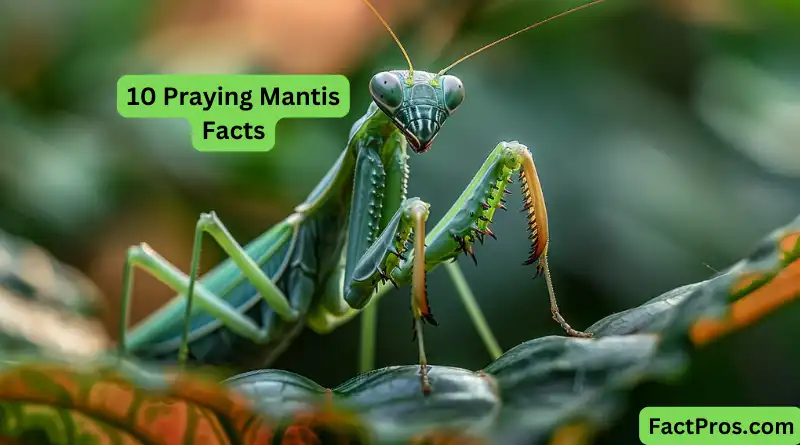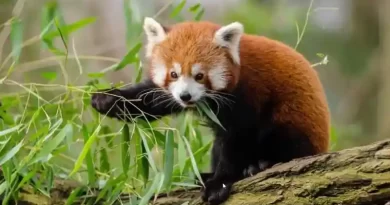10 Praying Mantis Facts
Introduction
Praying mantises are some of the most fascinating creatures in the insect world, and they’ve definitely earned their place as a source of endless curiosity. This article covers 10 amazing praying mantis facts. With their unique look and absolutely wild behaviors, these little predators are anything but ordinary. You’ve probably noticed their iconic praying stance, but that’s just the beginning of what makes them so captivating.From their elongated bodies and triangular heads to their razor-sharp forelegs, praying mantises are designed for survival. Their ability to blend into their surroundings and their almost 180-degree head rotation only add to their mystique. But they’re not just about looks—these guys are skilled hunters, taking down prey with precision that’s almost scary.
Insects are animals. Insects belong to the kingdom Animalia, which is the broad classification that includes all animals. Specifically, insects fall under the phylum Arthropoda, which includes invertebrates with exoskeletons, segmented bodies, and jointed appendages. Insects are the largest group within the animal kingdom, comprising millions of species with a vast diversity of forms and behaviors. So, while insects might seem quite different from other animals like mammals or birds, they are indeed part of the same overarching kingdom.
In this deep dive, I’m going to take you on a journey into the incredible world of praying mantises. We’ll explore their most unique traits, jaw-dropping behaviors, and the surprising secrets that help them thrive. Whether you’re an insect enthusiast or just someone who’s curious about the natural world, these ten facts are sure to leave you totally amazed by the extraordinary life of the praying mantis.
Dissecting Praying Mantis: Understanding Its Taxonomy and Nomenclature
The praying mantis, scientifically classified as belonging to the Mantodea order, stands out as an intriguing and unique insect in the world of taxonomy. Within this order, numerous families, subfamilies, and species further categorize these fascinating creatures. The Mantodea order itself is part of the class Insecta, one of the most diverse classes in the animal kingdom, comprising a vast array of creatures.
Taxonomic Hierarchy:
- Kingdom: Animalia
- Phylum: Arthropoda
- Class: Insecta
- Order: Mantodea
Nomenclature:
The term “praying mantis” refers to the typical stance these insects adopt, resembling a prayerful position. However, the scientific nomenclature for various species may differ, highlighting the nuanced characteristics and features that differentiate one species from another.
Given the diverse nature of praying mantises, taxonomists have identified and named numerous species, each with its unique set of biological traits and behavioral patterns. When these species are named, their morphological and genetic traits are carefully studied. This often leads to the discovery of new features that make them worthy of being named as new species or subspecies in the Mantodea order.
10 Facts You Should Know About Praying Mantis
1. Master of Camouflage
Praying mantises have evolved remarkable camouflage techniques, enabling them to blend seamlessly into their surroundings. Their elongated bodies and various colorations, including shades of green, brown, and even pink, allow them to mimic foliage and ambush unsuspecting prey. This adaptive ability gives them a distinct advantage in capturing food while avoiding detection by predators.
2. Unusual Head Movement
The praying mantis is renowned for its unique ability to rotate its head almost fully around its body. This extraordinary mobility aids in their vigilant observation of the environment, ensuring they can spot potential prey or detect approaching threats from multiple directions without needing to adjust their body position. This exceptional trait contributes to their effectiveness as skilled hunters.
3. Carnivorous Diet
Praying mantises exhibit a strict carnivorous diet, preying on a diverse range of insects such as moths, crickets, grasshoppers, and flies. Their agile and swift movements, combined with their powerful forelegs, enable them to capture and grasp their prey with impressive accuracy, often consuming it while it is still alive.
4. Religious Stance
The term “praying” in their name originates from the position they assume, with their front legs folded as if in prayer. This posture, also known as a “threat display,” serves as a deceptive tactic to remain inconspicuous while waiting for unsuspecting prey to come within striking range. Despite the misleading connotation, this behavior is purely instinctual and serves a crucial purpose in their predatory strategy.
5. Exceptional Predatory Skills
Praying mantises possess specialized forelegs equipped with spines and sharp, serrated edges, enabling them to grasp and immobilize their prey with exceptional precision and strength. Their lightning-fast reflexes, combined with their ability to remain perfectly still until the opportune moment arises, make them formidable hunters within their ecological niche.
6. Cannibalistic Behavior
While not universal across all species, cannibalism is a notable phenomenon observed in some praying mantis populations, particularly during or after mating. This behavior, observed more commonly among certain species, may be attributed to various factors, including nutrient acquisition or ensuring the success of the female’s reproductive efforts. However, not all species exhibit this behavior, and some have alternative mating strategies to avoid such instances.
7. Incomplete Metamorphosis
Praying mantises undergo an incomplete metamorphosis, which means they experience three distinct stages in their life cycle: egg, nymph, and adult. Nymphs closely resemble miniature versions of adults, with similar body structures and habits. As they progress through several molting stages, their bodies grow larger and develop wings, eventually reaching their adult form.
8. Great Vision
Praying mantises possess exceptional vision due to their two large compound eyes, which provide them with a broad field of view. Their ability to detect subtle movements from a considerable distance allows them to identify potential prey quickly. This acute vision is vital for their hunting success, enabling them to swiftly capture agile insects in their environment.
9. Global Distribution
Praying mantises have established a global presence, inhabiting almost every continent worldwide, with the exception of Antarctica. They exhibit adaptability to a wide range of environments, including tropical rainforests, temperate grasslands, and even urban areas. Their diverse habitat preferences demonstrate their resilience and ability to thrive in various ecological conditions.
10. Ecosystem Benefits
Despite their predatory nature, praying mantises contribute to ecosystem balance by helping control insect populations. They serve as natural pest controllers, preying on a variety of insects that may otherwise cause harm to agricultural crops and garden plants. By regulating the populations of pest species, praying mantises play a crucial role in maintaining the equilibrium of various ecosystems, making them valuable allies in natural pest management.
Unveiling the Diverse Sub-Families of the Praying Mantis: Exploring the Mantodea Taxonomic Branches
Within the captivating realm of praying mantises, an intricate classification system reveals the existence of various sub-families, each characterized by distinct traits and features. These subdivisions within the Mantodea order offer a deeper understanding of the evolutionary pathways and specialized adaptations that have shaped the diverse branches of this intriguing insect lineage.
The Enigmatic Mantodea Sub-Families:
1. Amelinae
Members of the Amelinae sub-family often display vibrant colorations and striking physical attributes, captivating enthusiasts and researchers alike. This sub-family encompasses a range of species known for their unique behavioral patterns and intricate hunting techniques.
2. Mantinae
Representing a diverse group of praying mantises, the Mantinae sub-family boasts a wide array of species that exhibit remarkable adaptations to their respective environments. From their distinctive body structures to their sophisticated camouflage mechanisms, these mantises have evolved various strategies to thrive in their habitats.
3. Hymenopodinae
Within the Hymenopodinae sub-family, praying mantises demonstrate a remarkable blend of agility and predatory prowess. These species often possess elongated bodies and robust forelegs, allowing them to capture agile prey with exceptional speed and precision, making them formidable hunters in their ecosystems.
4. Acromantinae
The Acromantinae sub-family stands out with its members’ extraordinary mimicry abilities and intricate behavioral adaptations. These mantises have developed sophisticated camouflage techniques, enabling them to blend seamlessly into their surroundings and remain undetected by both potential prey and predators.
Praying Mantis: A Guardian of Balance in the Ecosystem
In the intricate tapestry of the natural world, the praying mantis emerges as a crucial guardian of balance within various ecosystems. From their pivotal position in the food chain to their impact on pest control, the presence of praying mantises contributes significantly to the overall health and equilibrium of diverse natural environments.
Natural Pest Control
Praying mantises are like nature’s pest control experts. They love to munch on a wide range of insects that can harm crops and gardens. Their big appetite for pests like aphids, flies, and caterpillars helps keep these bug populations in check. By doing this, they prevent infestations that could mess up the balance in local ecosystems. Because they’re such effective hunters, praying mantises reduce the need for harmful chemical pesticides, making pest control more natural and sustainable.
Influence on Food Webs
Praying mantises play an important role in the food web. They’re both predators and prey. While they eat a variety of insects, they also become food for birds, reptiles, and small mammals. This makes them a vital part of the energy flow in ecosystems. By being part of this web, they help support the survival of different animal populations and keep the natural balance going strong.
Indicator of Environmental Health
Praying mantises can be a sign of how healthy an ecosystem is. If their numbers go up or down, it can show how well the environment is doing. They’re sensitive to changes in temperature and habitat, which makes them great indicators of environmental health. By keeping an eye on praying mantis populations, researchers can learn a lot about the health of an area. This helps guide efforts to protect the diversity and balance of species in the ecosystem.
Contribution to Biodiversity
Praying mantises play an important role in keeping their ecosystems healthy. They add to the variety of life in their habitats and show how diverse and strong nature can be. Their unique behaviors and hunting skills are key examples of how different species depend on each other to keep things balanced in the natural world.
As both hunters and protectors, praying mantises help maintain this balance. This highlights how important it is to protect their habitats and ensure that nature and humans can coexist peacefully. Every species, no matter how small, has a role in keeping ecosystems stable. For example, bees help pollinate plants, and fungi break down dead matter. If these relationships were lost, it could disrupt the entire balance of life.
Praying mantises remind us of how connected all living things are and how each one plays a part in sustaining the web of life.
Praying mantises are carnivorous and primarily feed on other insects like flies, crickets, and moths. Larger species may even consume small reptiles, birds, and mammals.
Praying mantises typically live for about a year. In the wild, they usually survive from spring to fall, while in captivity, they may live slightly longer.
Yes, praying mantises can bite humans, but this is rare and usually happens only if they feel threatened. The bite is not venomous and poses little harm.
Yes, this behavior, known as sexual cannibalism, is observed in some species of praying mantises. However, it doesn’t happen in all species or in every mating scenario.
It is not advisable to keep multiple praying mantises together, as they are solitary creatures and may resort to cannibalism, especially as they grow older




